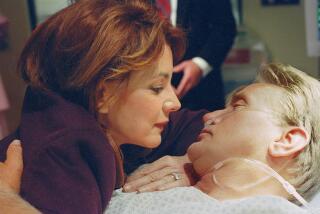SHOT HEARD ‘ROUND THE NEWS ROOMS
- Share via
It was the ultimate media stunt, the big bang in front of the cameras, in plenty of time to make the evening news.
But having it was no reason to show it.
So the networks, CNN and Los Angeles TV stations used good judgment on their Thursday newscasts by not showing Pennsylvania State Treasurer R. Budd Dwyer actually put the barrel of a .357 magnum pistol into his mouth and pull the trigger.
TV is not shy about showing violence and anguish. Filling the screen with Dwyer’s death-contorted face, though, could serve no purpose other than to exploit a tragedy for the sake of gruesome, unforgettable TV.
Stations here covered the story in varying degrees, including using footage of Dwyer with the gun as others pleaded with him to put it down. Happily, the pictures stopped there.
Hence, Los Angeles viewers--who are accustomed to the most outrageous media spectacles--were at least spared the Super Bowl of suicides.
Not all newspaper readers were, though. Some local papers (including one edition of The Times) ran wire-service photos of “the moment of impact” as Dwyer pulled the trigger. Imagine picking up your paper and, without warning, seeing that. It was ghastly. It was unnecessary. It had the potential to traumatize.
The suicide was reportedly shown to its bloody conclusion on some stations in Pennsylvania, too. Ugh!
Everyone had footage of Dwyer’s grisly public act, which came a day before he was to be sentenced in federal court for fraud. Of course , they had footage. The man wanted his death televised, photographed and written about in every newspaper in the land.
So he called a press conference in Harrisburg on Thursday, where he made a half-hour statement in front of reporters and cameras, professing innocence and blaming his troubles on the legal system. Then came the surprise, as he produced a pistol from a large manila envelope and shot himself.
Dwyer orchestrated his own obituary.
Death on camera has a tradition, from the assassination of Lee Harvey Oswald to the fatal stabbing of a Japanese socialist leader in 1960 that Japanese TV aired again and again.
To air or not to air is always a tough judgment call in a medium in love with violence, and the Dwyer story must have sparked debates in newsrooms across the nation.
If TV sends suicides into our homes, though, which domino falls next? Televised hangings? Murders?
On very rare occasions, they should be shown.
Dwyer’s story appeared in newscasts, for example, that also carried footage of unarmed anti-government demonstrators in Manila being shot down by apparently panicking Filipino troops. Death in the streets, chaotic, revealing images of post-Marcos Philippines.
Now flash back to the 1960s. Nothing from Indochina better conveyed the excesses of war than shocking pictures of a young Vietcong suspect having his brains blown out at point-blank range by South Vietnam Police Chief Nguyen Loan in 1968. TV was revolting that day--but important.
From the same era came TV pictures of Buddhist monks in Vietnam who torched themselves before the media to protest the Saigon government, fiery suicides that showed Americans another side of the conflict there.
Dwyer’s suicide, though, was merely the act of a desperate, troubled man that became national news only because he had summoned the unsuspecting media to witness it. If he had ended his life in private, his suicide would have merited slight notice outside his home state.
So his media stunt worked, even though most of the media used relative restraint in reporting the story.
A few questions from the devil’s advocate:
Didn’t TV owe us this one, though? Hasn’t the smallness of the screen diminished the impact of death, and even the most violent entertainment programs always softened death to meet TV’s criteria for diffused reality?
Wouldn’t Dwyer blowing himself away in front of our eyes, in blood-splattering color, be a walloping, realistic counterpoint to TV’s sanitized violence?
But to what end? Surely we already know what happens when a man shoots himself through the mouth? Or we can guess. And surely what TV news needs least are more horror spectaculars and gratuitous pictures of human carnage.
“If suicides are going to be media events, then we’re all in trouble,” said Pete Noyes, managing editor for KNBC Channel 4 news, which stood alone locally in running no footage of the Dwyer press conference.
Channel 4 merely reported the story and showed a picture of Dwyer.
Other stations showed segments of the news conference up to the point of Dwyer inserting the barrel and pulling the trigger. KTTV Channel 11 added one touch, using the sound of the gunshot over a freeze-frame of Dwyer holding the pistol.
“I’m offended by this,” Noyes said about even the limited coverage on other Los Angeles stations. “We don’t report suicides unless they’re extraordinary, like Marilyn Monroe. We feel that reporting suicides might encourage border-line people who are thinking of doing it themselves.”
That’s a humane policy. But worrying about potential copycats can be carried to the extreme.
You can make a case for not airing the Russian roulette scene in “The Deer Hunter” in light of numerous fatal Russian roulette shootings seemingly linked to watching the movie on TV. The evidence of cause and effect is simply too strong. Yet lawsuits invariably fail when seeking to blame real-life crime and violence on the influence of TV.
Dwyer publicly shot himself, by the way, only several weeks after an episode of NBC’s “L.A. Law” depicted a lawyer fatally shooting himself in court.
Even if Dwyer were influenced by “L.A. Law,” though, what should be done? Never show anything on TV that may trigger violence in an unbalanced person? TV might as well fold up, for experience shows that twisted minds can be set off even by benign images.
To air or not to air? R. Budd Dwyer is dead, but the debate lingers.
More to Read
The complete guide to home viewing
Get Screen Gab for everything about the TV shows and streaming movies everyone’s talking about.
You may occasionally receive promotional content from the Los Angeles Times.






